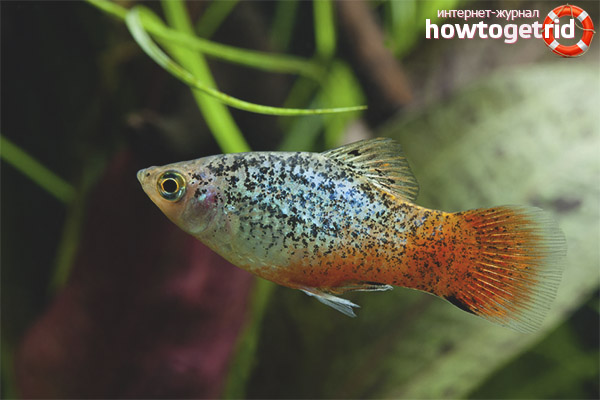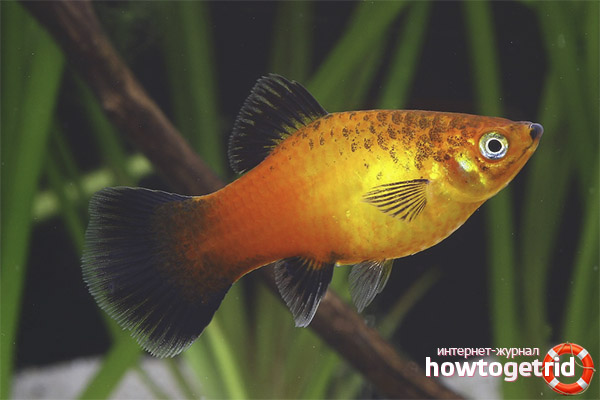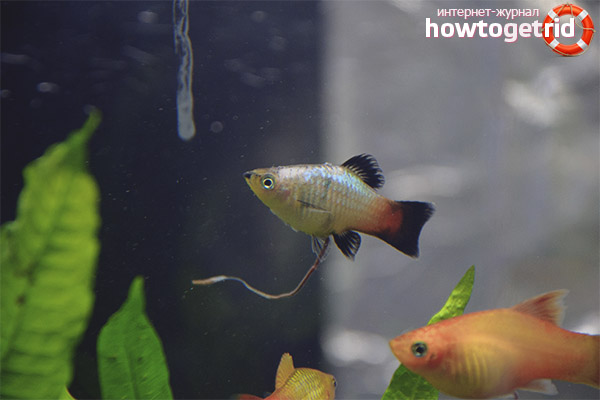The content of the article
Pecilia is a beautiful and unusual fish. It’s easy to take care of her. Therefore, it can be acquired even by one who has absolutely no experience in keeping aquarium fish. But, despite their unpretentiousness, you should still study some of the rules for their maintenance.
Living in nature
This species originated from South America. They can also be found in Guatemala and Mexico. Pecilia inhabit both large and small reservoirs. The water in them is fresh or brackish. The soil in these water bodies is muddy or consists of gravel. They have a lot of vegetation. Basically, Pecilia lives in bodies of water with stagnant water, but sometimes it also occurs in rivers that flow into the Atlantic Ocean. The most beautiful Pecilia live near the island of Yutakan. The color of these fish is yellow-brown. There are black spots. Colorful fish that can be seen in aquariums are artificially bred species.
The second name of these fish is molliesia. In European aquariums, it began to be bred in 1907. Pecilia appeared in Russia only after 50 years. To this day, this fish does not lose its popularity. Breeders are breeding new species that attract aquarists.
Appearance
Pecilia has a diamond-shaped body. It is quite high, elongated. The head is small. The eyes are large, the fins are rounded. The male has a length of 5.5 cm. The females are slightly larger - about 7 cm. The males have a more slender body, they have gonopodia. But on the tail they have no sword. If you follow the rules of care, Pecilia can live about 3 years.
To date, there are about 130 different colors of this fish.
Varieties
33 species belong to the genus. In addition, there are many hybrid forms. They vary in shape and color. Consider several varieties.
- Multicolor. Their colors are cast in all colors. Males in front are yellowish, while the back of them is blue. There are dark spots on the sides. The fins are yellow-red in color. Females are darker. They have olive, gray or other colors. On the sides they have a zigzag pattern in red.
- Black. In this case, the scales can cast green or blue.
- Berlin have a beautiful scarlet color.
In addition, there are types of red, blue, gold, etc.
Pecilia can also have a different body shape and fins. On this basis, they are divided into the following varieties.
- Classic.
- Radishes. These fish have an unusual fin shape.
- Cylinders Such portia have a swollen body. This feature is due to the fact that they came from the crossing of individuals with a short spine. The fry have a spine of normal shape and length. And when the fish grows up, it deforms.
- Sailing. This variety is much larger than ordinary pecilia. The fish have a very large dorsal fin.
Who can I live with?
These fish are generally distinguished by their friendliness. They can be in the same aquarium with representatives of their species, and with other fish. But it is better if their neighbors are the same peaceful and calm species that require the same living conditions.
By compatibility with Pecilia all fish can be divided into several groups.
- Scalaria, guppies, gurus and barbs get along very well with the specialties.
- With eels, they have medium compatibility.
- Do not settle these fish with aggressive predators. For example, cichlids, astronotes, etc.
Aquarium Maintenance
These fish are unpretentious. They can live in water with different temperatures.But, to make the fish as comfortable as possible, the following conditions should be observed.
- The aquarium may be small, but it is desirable that it be deep enough. This is due to the fact that Pecilia in nature used to live in the middle layer. Each fish should have at least about 2 liters of water. Some contain these fish even in jars of 10 liters. But it is better that it be an aquarium, the volume of which is at least 50 liters. The fish there will be much more comfortable, in addition, the aquarium can be made very beautiful by installing decor elements there. In the spacious "house", the Pecilians will have a place for games. It is important that the aquarium has a lid. There is a chance that the fish, playing, jump out of the aquarium and die.
- The most comfortable representatives of this species will feel in the water 22-25 degrees.
- Today, there are debates among aquariums about whether it is necessary to add water to them. Many are addicted to this. But you really can't do this too often. Salt will be an excellent tool if you need to cure weak and sick fish. If you constantly add salt to the water, the fish will lose their stamina. Will be susceptible to various diseases. Moreover, aquarists with no experience will not be able to maintain the correct level of salt content in water.
- A quarter of the water needs to be updated weekly. You can optionally install a filter. But Pecilia can live without it.
- To provide lighting in a small aquarium, you can put a low-power light bulb or use sunlight.
- It is advisable to pick up a dark soil. Plants should be planted in the aquarium, as well as more space for shelter for the pilgrims. Of algae, echinodorus, elodea, as well as hornwort and others are perfect. Algae need to be planted behind and on the sides. At the front, the space should be visible.
Feeding
These fish need to be fed well and varied. Only in this way will they have a beautiful color, will remain active. You can feed them with bloodworms, daphnia. Food can be of any kind - live, frozen, dry. Since the fish are small, then the feed should be quite small. Otherwise, the fish may choke. Feed should be given so that they ate it at a time. Otherwise, the remaining food will disappear, which will quickly spoil the water. This can lead to illness. Sometimes for a change you can give salad and various seaweed.
Breeding

Pecilia is a live-bearing fish. The entire gestation period usually lasts 28-40 days. However, they can spawn more than once a year. In one female, 30-80 fry are born. They gather in a flock and are near the surface, since at first they are very shy. For fry there is no need to buy special food. From the first days they can eat the same as adult fish. Aquarists breed these fish in several ways.
The first method we describe is used more often than others. From the aquarium, the pecilia is planted in a special spawning ground. Of all the born fry, the best ones are selected. The rest are recycled.
The second method is self-seeding. In this case, the fish remain in the general aquarium. But with this method, it is very important to ensure that neighbors in the aquarium do not destroy the fry. This method should not be used if swordsmen coexist with the pecillia in the aquarium. If guppies live in your tank, except for pecilia, you should also be careful. And in the case of cardinals, there is no cause for concern.
These methods are quite effective. But they are suitable only for those who do not set themselves the goal of breeding individuals that have an original appearance and color. To get such fish - use the third method.
Third way: fish are planted in several aquariums with a volume of 20 liters. In each aquarium, the number of females should exceed the number of males.In addition, you will need 2 more aquariums of 50 liters and 2 of 100 liters. In these aquariums fry are settled, which are divided by sex and color.
Health
In general, they are quite hardy, but can get sick due to the low temperature of water or bacteria. They can get into the aquarium with water or food. Fins can begin to rot in fish, develop a fungus or infection. So that the rest of the individuals do not get sick, patients should be put off during treatment. They should be kept in warmer water. Water should be salted.
Interesting features
A very unusual feature of these fish is that the female can change her gender. This may happen due to non-compliance with the conditions of detention. In addition, if the peculiarities are in an aquarium with swordsmen, then they can interbreed with them and degenerate.
If you do not have experience, but really want to start an aquarium, then Pecilia is ideal for you.
Video: Pecilia aquarium fish











Submit